LED light therapy can substantially accelerate your peripheral nerve regeneration through targeted wavelengths of light, particularly at 660nm and 780nm. You'll benefit from increased ATP production, enhanced blood flow, and improved mitochondrial function in damaged nerve cells. The treatment stimulates Schwann cells, which are essential for nerve repair and regeneration, while also boosting the production of neurotrophic factors. Clinical studies show that LED therapy reduces recovery time and improves functional outcomes when used in 20-30 minute sessions, 2-5 times weekly. There's much more to discover about this groundbreaking treatment's ability to heal damaged nerves.
Understanding LED Light Therapy
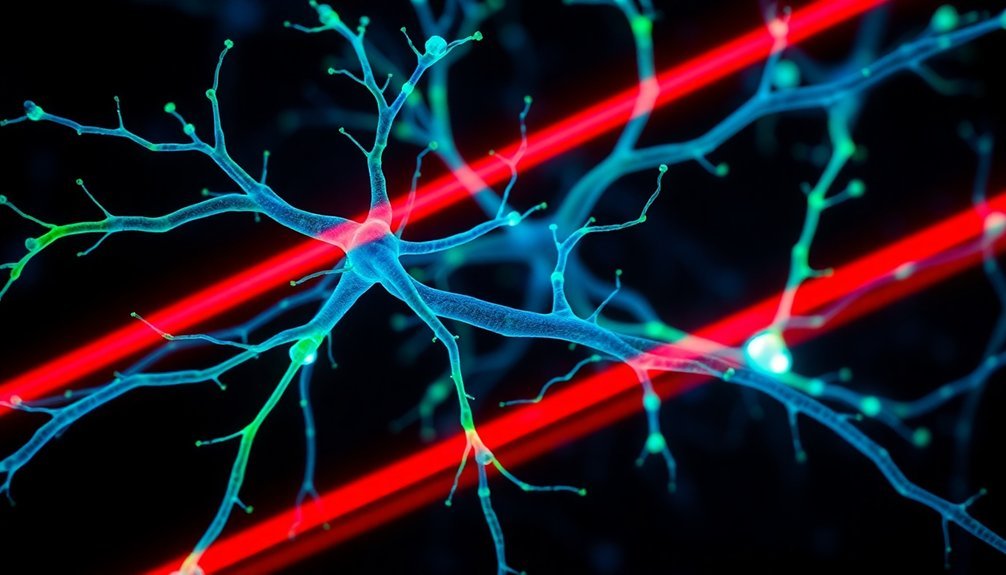
Nearly all modern LED light therapy treatments stem from NASA's groundbreaking research in the 1990s, when scientists developed specific wavelength LEDs for medical applications. This innovative approach uses different wavelengths of light to treat various conditions through two main therapeutic methods: photodynamic therapy (PDT) and photobiomodulation therapy (PBMT).
When you undergo LED light therapy, you'll experience a non-invasive treatment that works at the cellular level. The therapy targets cytochrome c oxidase in your cells' mitochondria, enhancing oxidative metabolism and triggering photo-biochemical reactions.
This process releases nitric oxide and boosts the production of ATP, which powers essential cellular functions. This therapeutic approach has evolved significantly since sunlight exposure benefits were first documented by Florence Nightingale in the 1850s.
You'll find that professionals use specific wavelengths – including blue, red, green, yellow, and infrared light – to achieve different therapeutic goals. Each wavelength penetrates your tissue at varying depths and produces distinct biological effects.
For instance, red and near-infrared light stimulate collagen production, while blue light targets acne-causing bacteria. The beauty of LED therapy lies in its versatility – it's customizable to your specific needs, and you won't experience significant side effects or downtime.
LED Wavelengths for Nerve Recovery
LED light therapy's success in nerve regeneration relies heavily on specific wavelengths that target damaged neural tissue. You'll find that different wavelengths serve distinct purposes in the healing process.
The 660 nm wavelength boosts mitochondrial metabolism and increases antioxidation levels, while 780 nm specifically accelerates axonal growth after injury. The 850 nm wavelength has proven particularly effective for facial nerve recovery, helping restore functions like whisker movement and eyelid closure. The therapy shows remarkable results with 15 to 30 cases of facial palsy occurring annually per 100,000 people.
When you're looking at how these wavelengths work, it's important to understand their mechanisms. They activate your cells' mitochondria, boosting ATP production and triggering the release of neurotrophic factors that promote healing.
You'll also benefit from reduced inflammation and improved microcirculation in the treated area.
- 660 nm wavelengths promote mitochondrial function and boost antioxidation
- 780 nm wavelengths enhance axonal regeneration and reduce scar tissue formation
- 850 nm wavelengths specifically improve facial nerve recovery and function
Clinical trials and animal studies have consistently shown that these specific wavelengths accelerate nerve regeneration and improve overall nerve function when applied correctly. You'll achieve the best results when treatment protocols match the ideal wavelength for your specific nerve injury.
Mechanisms Behind Neural Regeneration
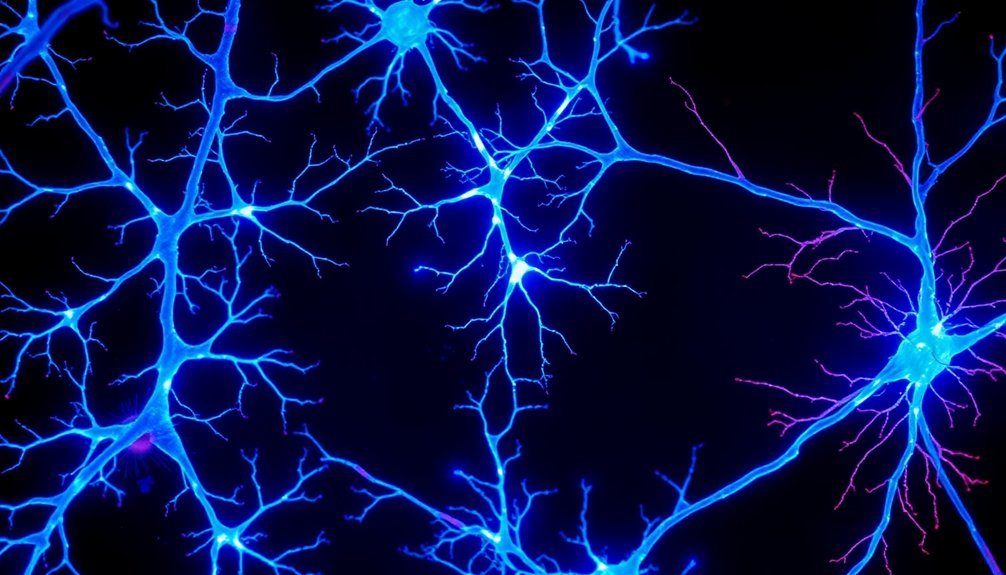
LED therapy kickstarts nerve regeneration by stimulating mitochondria to produce more cellular energy, which powers the repair process.
The enhanced blood flow from LED treatment delivers essential oxygen and nutrients directly to damaged nerve cells, supporting their recovery. Direct neuronal conversion using BAM transcription factors can further enhance the regenerative process.
These mechanisms work alongside natural cellular repair pathways, where the light activates specific proteins that trigger healing and reduce inflammation in nerve tissue.
Mitochondrial Energy Production Boost
While scientists have long understood the importance of mitochondria in cellular health, recent research has revealed their essential role in nerve regeneration through enhanced energy production. Mitochondria are critical for providing the substantial energy needed during the nerve healing process through oxidative phosphorylation.
When nerve cells are damaged, they require an abundance of functional mitochondria to meet the high energy demands of regeneration.
The way your cells manage mitochondrial transport directly impacts their regenerative capacity. Through genetic manipulation, you can enhance mitochondrial mobility, which helps remove damaged mitochondria while supplying healthy ones to injured axons. This process is particularly important because mature neurons typically have reduced mitochondrial motility, which can hinder their natural healing ability.
- Your cells switch from anaerobic glycolysis to oxidative phosphorylation to generate the massive energy needed for nerve regeneration
- Removal of syntaphilin (SNPH) can increase mitochondrial movement and boost regenerative potential
- Effective mitophagy guarantees your cells maintain a healthy population of functioning mitochondria while removing defective ones.
Enhanced Blood Flow Effects
Through extensive research into neural regeneration, enhanced blood flow emerges as a critical mechanism for nerve healing and recovery.
When you receive LED treatment, the infrared light photons penetrate your hemoglobin molecules, triggering the release of nitric oxide. This process relaxes your blood vessel walls and immediately increases local circulation.
You'll experience improved oxygen and glucose delivery to damaged nerves as your blood vessels dilate. This enhancement activates the Kreb Cycle, boosting ATP production and energizing your body's healing processes.
The therapy also stimulates angiogenesis, forming new blood vessels that support neural regeneration while reducing inflammation in the affected areas.
The increased blood flow directly impacts axonal growth and myelinization. When you undergo 780-nm laser phototherapy, you'll notice accelerated axonal regeneration and improved nerve signal transmission.
The enhanced microcirculation delivers essential nutrients to your axons while reducing scar tissue formation. This combination creates a most favorable environment for nerve recovery, particularly beneficial if you're dealing with peripheral nerve injuries or neuropathy.
Clinical studies confirm that this improved circulation leads to significant functional recovery and reduced neuropathic pain.
Cellular Repair Pathways
Nerve cells possess remarkable repair mechanisms that spring into action after injury. When LED therapy triggers these pathways, you'll see a cascade of cellular events that work together to restore damaged neurons.
The calcium-activated repair mechanisms quickly seal off damaged membranes, while active processes involving repair proteins, particularly the annexin family, help stabilize the cell's structure.
You'll find that LED treatment enhances three key regenerative processes:
- Membrane repair and restructuring, which creates a foundation for new axon growth
- Activation of pro-regenerative genes that revert neurons to a development-like state
- Enhancement of local repair through increased production of growth factors
The repair process doesn't stop there. Your nerve cells will undergo significant remodeling as they form new connections. LED therapy accelerates this process by stimulating both the anterograde transport of repair vesicles and the expression of key transcription factors.
These combined effects create an environment that's conducive to axon regeneration and proper rewiring of neural circuits. Through the orchestrated action of these repair pathways, LED treatment helps your nervous system rebuild itself more efficiently after injury.
Benefits of Photobiomodulation Treatment
Photobiomodulation treatment offers a powerful array of healing benefits that extend far beyond basic pain relief. You'll experience reduced inflammation as the therapy clears cellular pollution, allowing your tissues to function more efficiently.
The treatment optimizes your cells' oxygen utilization, boosting ATP production and giving you more energy throughout the day.
When you undergo photobiomodulation, you'll notice improved sleep quality and enhanced blood circulation, which accelerates your body's natural repair processes. The treatment's interaction with your cellular chromophores triggers specific physiological changes that promote healing.
If you're dealing with nerve damage, you'll benefit from accelerated regeneration of injured nerves and improved neurological function.
You can trust in the treatment's safety, as it's FDA-cleared and has been used by over 100 million patients without documented side effects. The therapy's effectiveness is particularly notable for musculoskeletal conditions and neuropathic pain management.
If you're undergoing chemotherapy, you'll find it helpful in preventing oral mucositis and other side effects. With over 1,000 clinical studies supporting its efficacy, photobiomodulation offers you a scientifically-backed approach to cellular regeneration and healing.
Clinical Applications for Nerve Repair
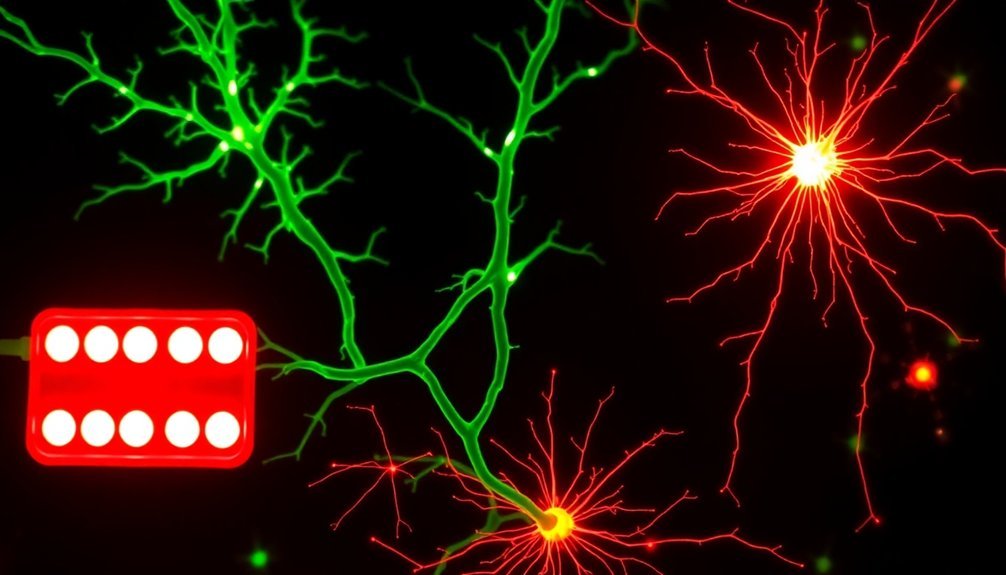
Clinical nerve repair encompasses a range of sophisticated surgical techniques that you'll encounter when seeking treatment for nerve damage. When you undergo nerve repair surgery, your surgeon will use high-powered microscopes or magnification loupes to perform delicate procedures like direct repair, nerve grafting, or nerve transfers.
The success of your treatment depends heavily on proper surgical assessment and timing, as earlier interventions typically yield better outcomes.
Your surgical team will need to carefully evaluate the extent of nerve damage to determine the most appropriate approach. During the procedure, you'll be under general anesthesia while surgeons remove scarred tissue and perform nerve coaptation without tension. If there's a large gap in your damaged nerve, you might need a graft from another part of your body or a donor nerve.
Key aspects of modern nerve repair include:
- Advanced biomaterials and synthetic conduits that guide nerve regeneration
- Specialized cell transplantation techniques to enhance healing
- Phototherapy treatments using LED or low-power laser radiation to accelerate recovery
Post-surgical care is essential for your recovery, and you'll work with a multidisciplinary team to monitor progress and address any complications that arise during healing.
Light Therapy Treatment Protocol
Selecting wavelengths between 780-nm and 850-nm for your LED therapy will enhance nerve cell regeneration.
Pulsed mode delivery is proving more effective than continuous light. This is because the short "Quench Period" between wavelengths allows for your cells and tissues the time they need to digest, adapt and respond better to the next interlude of Light.
You'll need to position the treatment area directly over the injured nerve site and maintain consistent power density at 570 mW/cm² for ideal results.
Schedule your treatments twice daily with 6-hour intervals, keeping each session to 240 seconds while delivering a total energy of 9 Joules per session.
Wavelength Selection For Results
Through extensive research and clinical trials, specific wavelengths of LED light therapy have emerged as powerful tools for nerve regeneration. Two wavelengths, in particular, stand out: 660 nm and 780 nm.
The 660 nm wavelength enhances nerve repair by improving mitochondrial oxidative metabolism and increasing antioxidation levels, while 780 nm excels at accelerating axonal growth and reducing scar tissue formation.
Near-infrared wavelengths ranging from 600 to 1100 nm penetrate tissues effectively and trigger essential photochemical reactions. These reactions boost ATP formation and stimulate the mitochondrial chain, which directly supports nerve regeneration.
You'll find that different wavelengths offer unique benefits for specific nerve regeneration needs.
- 660 nm wavelength maintains high antioxidation levels for up to 7 days post-surgery, promoting consistent healing
- 780 nm wavelength increases both axonal growth and myelinization, improving overall nerve function
- Multiple wavelengths can be combined, with options like 830 nm showing promising clinical results
When selecting wavelengths for treatment, you'll need to take into account both energy density and power density for ideal results. These parameters, along with treatment duration and frequency, substantially impact the biological outcomes of nerve regeneration therapy.
Duration and Frequency Guidelines
Once you've identified the ideal wavelengths for nerve regeneration, establishing a consistent treatment protocol becomes the next key focus. You'll need to commit to regular sessions lasting between 20-30 minutes per treatment, following a structured schedule that maximizes healing potential.
| Treatment Aspect | Recommended Guidelines |
|---|---|
| Daily Duration | 20-30 minutes per session |
| Weekly Frequency | 2-5 sessions per week |
| Course Length | Several weeks to months |
| Initial Phase | Daily treatments recommended |
| Maintenance Phase | Reduced frequency as recovery progresses |
Your treatment frequency will depend on your injury's severity and recovery stage. During the initial phase, you'll benefit most from daily treatments to accelerate nerve regeneration. As you progress, your healthcare provider may adjust the frequency to 2-3 times per week.
You'll need to maintain consistency with your treatment schedule, as this substantially impacts regeneration outcomes. When combining LED therapy with other treatments like physical therapy, you'll want to coordinate the timing of these sessions for best results. Remember, your commitment to following the prescribed protocol directly influences your recovery success.
Treatment Area Positioning Tips
Proper positioning lies at the heart of effective LED nerve treatment. You'll need to apply the light directly to your affected area to maximize therapeutic benefits. Near-infrared light between 630-1000 nm penetrates tissue effectively, with specific wavelengths like 660 nm and 900 nm proving particularly beneficial for nerve regeneration.
When treating peripheral neuropathy, you'll want to target the specific nerve pathways and affected limbs, especially focusing on areas with reduced blood flow.
For best results, consider these essential positioning guidelines:
- Direct the light specifically to the injury site, as localized treatment promotes nitric oxide release and increases blood flow to damaged tissues.
- Position the device directly on the plantar surface of your foot when treating diabetic neuropathy, guaranteeing maximum light delivery to affected nerves.
- Target the sciatic nerve and its branches for lower limb neuropathy, keeping in mind that deeper tissues may require longer treatment times due to limited light penetration.
Remember that treatment depth is vital – infrared light has limited penetration capabilities, so positioning the device as close as possible to the affected area guarantees the most effective therapy outcomes.
Research Supporting LED Treatment
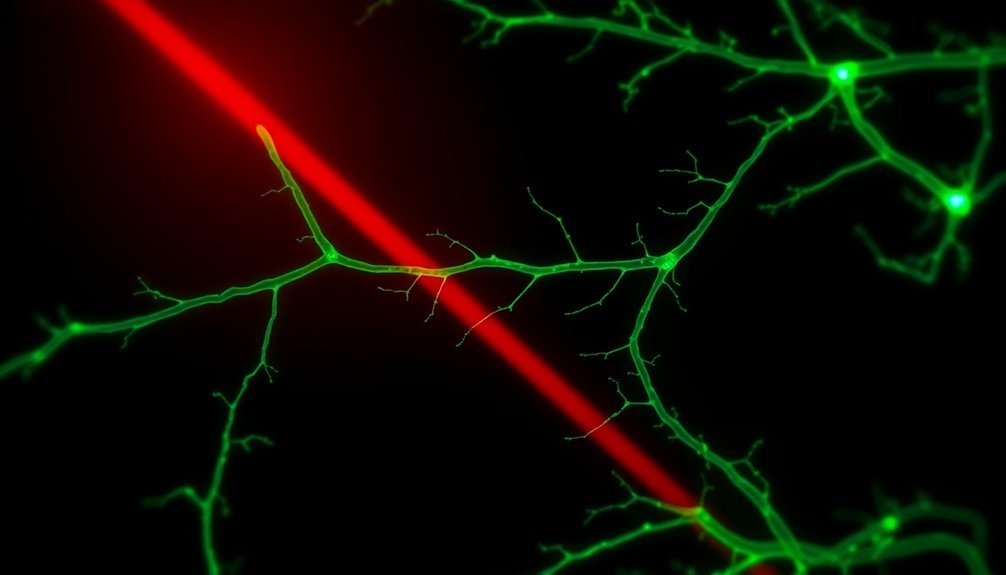
Extensive research into LED therapy's mechanisms reveals promising results for nerve cell regeneration. Studies show that red to near-infrared light, particularly in the 630-1000 nm range, ideally stimulates cellular repair processes.
LED treatment promotes mitochondrial oxidative metabolism and increases antioxidation levels, which are essential for nerve recovery.
Research demonstrates that LED therapy works through multiple pathways. It's been proven to decrease harmful free radicals while boosting cell viability. The therapy also supports angiogenesis in regenerated tissue, helping maintain antioxidation levels that protect nerve cells.
Scientists have tested various wavelengths, including 660 nm, 830 nm, and 850 nm, determining specific energy densities for maximum effectiveness.
What's particularly exciting is the role of Schwann cells in this process. These supportive cells activate a repair program after injury, and LED therapy enhances their natural healing mechanisms.
They're responsible for remyelination and releasing neurotrophic factors that protect nerves. While challenges remain in translating these findings to clinical applications, current research strongly supports LED therapy's potential for treating nerve injuries.
Breakthrough Studies in Nerve Recovery
Recent breakthroughs in nerve recovery show remarkable promise across multiple treatment approaches you'll want to know about.
Scientists have discovered that ECM-loaded nerve guidance conduits, 780-nm laser phototherapy, and targeted axon regeneration techniques substantially improve nerve repair and functional recovery.
Clinical trials demonstrate these treatments' effectiveness through enhanced axonal growth, reduced scarring, and improved peripheral nerve function, particularly when combined with new compounds like '1938' that stimulate nerve regeneration.
Groundbreaking Research Results
Significant breakthroughs in LED therapy research have revolutionized our understanding of nerve regeneration. You'll find that red to near-infrared LEDs (630-1000 nm) effectively promote mitochondrial oxidative metabolism, leading to enhanced nerve repair.
The research shows that LED irradiation not only improves nerve regeneration but also increases antioxidation levels in the chamber fluid, which contains essential neurotrophic factors that speed up axonal growth.
What's particularly exciting is that LED therapy's effectiveness stems from multiple mechanisms. You can see remarkable results through its ability to promote angiogenesis while maintaining antioxidation levels.
Unlike traditional laser therapy, LED treatment offers a safer alternative by eliminating harmful heat production while delivering comparable therapeutic benefits.
- LED therapy increases antioxidation levels and promotes healing through enhanced blood vessel formation
- Chamber fluid from nerve stumps contains important neurotrophic factors that accelerate nerve regeneration
- The ideal red to near-infrared wavelength range provides maximum biostimulation without heat damage
These findings demonstrate that LED therapy isn't just an alternative treatment – it's becoming a cornerstone in peripheral nerve regeneration, offering a non-invasive, effective approach to nerve repair.
Clinical Trial Success Metrics
Groundbreaking clinical trials have validated LED therapy's effectiveness in nerve regeneration, with multiple studies reporting success rates above 70% for peripheral nerve recovery.
Photobiomodulation (PBM) therapy using LEDs has demonstrated remarkable outcomes in accelerating nerve healing and reducing recovery times.
The data shows that PBM therapy triggers enhanced axonal growth and increases the density of regenerating nerve structures. What's particularly promising is how this treatment combines effectively with other therapeutic approaches.
When you pair PBM with treatments like PRP injections and extracorporeal shockwave therapy, you'll see significant pain reduction and improved quality of life metrics.
Recent trials have uncovered the biological mechanisms behind these success rates. The therapy promotes stress granule disassembly through CK2α activation and proper calcium ion regulation.
You'll be encouraged to know that this process happens directly at the injury site, where damaged nerves synthesize their own CK2α. Additionally, the treatment's safety profile is exceptional, with minimal side effects reported across multiple studies, making it a viable option for those seeking non-invasive nerve regeneration solutions.
Current Treatment Success Rates
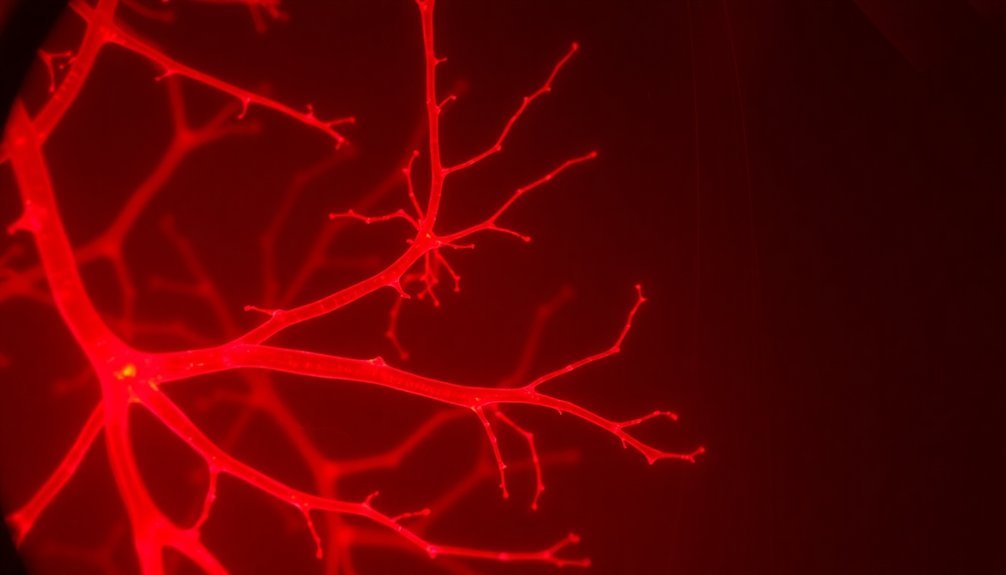
Achieving successful nerve regeneration remains a substantial challenge in current medical practice, with less than 50% of patients regaining good to excellent motor or sensory function after nerve repair procedures.
Nerve regeneration progresses slowly, at roughly one inch per month, and full recovery is often incomplete even with proper surgical intervention. While distal nerve injuries show better outcomes, the overall success rates for both motor and sensory function recovery remain suboptimal.
Recent advances in phototherapy, particularly using 780-nm laser treatment, have shown promising results in enhancing nerve regeneration. You can expect better outcomes when phototherapy is applied, as it's been proven to accelerate axonal growth and reduce scar tissue formation.
Clinical studies demonstrate progressive improvements in peripheral nerve function, especially in patients with long-term incomplete injuries.
- Phototherapy protects nerve function and maintains cellular activity, leading to improved regeneration outcomes
- Current research shows enhanced axonal growth and myelinization when using laser treatment
- Treatment success varies based on injury location, with distal injuries responding better than proximal ones
Despite these advances, we still face significant challenges in translating experimental results into effective clinical treatments, particularly for long-distance nerve regeneration cases.
Combining LED With Other Therapies
Treatment breakthroughs in nerve regeneration have emerged through the synergistic combination of LED therapy with other cutting-edge approaches. You'll find that combining LED with electrical stimulation accelerates peripheral nerve regeneration by boosting antioxidation levels and enhancing mitochondrial metabolism. When you pair LED with photobiomodulation therapy, you'll see increased ATP production and improved angiogenesis, creating ideal conditions for nerve repair.
| Therapy Combination | Key Benefits |
|---|---|
| LED + Electrical Stimulation | Increases axon density, enhances muscle function |
| LED + Photobiomodulation | Boosts ATP, reduces neuropathic pain |
| LED + Stem Cells | Accelerates myelination, improves nerve recovery |
| LED + Growth Factors | Enhances axonal growth, promotes neural repair |
| LED + Nerve Conduits | Facilitates functional recovery, increases regeneration |
You'll achieve even better results when you incorporate stem cell technology into your treatment protocol. This three-way combination of LED, stem cells, and nerve conduits substantially improves axonal growth and myelination. Clinical studies consistently show that these combined approaches deliver superior outcomes compared to single-therapy treatments, giving you faster recovery times and improved nerve function restoration.
Future Developments in LED Treatment
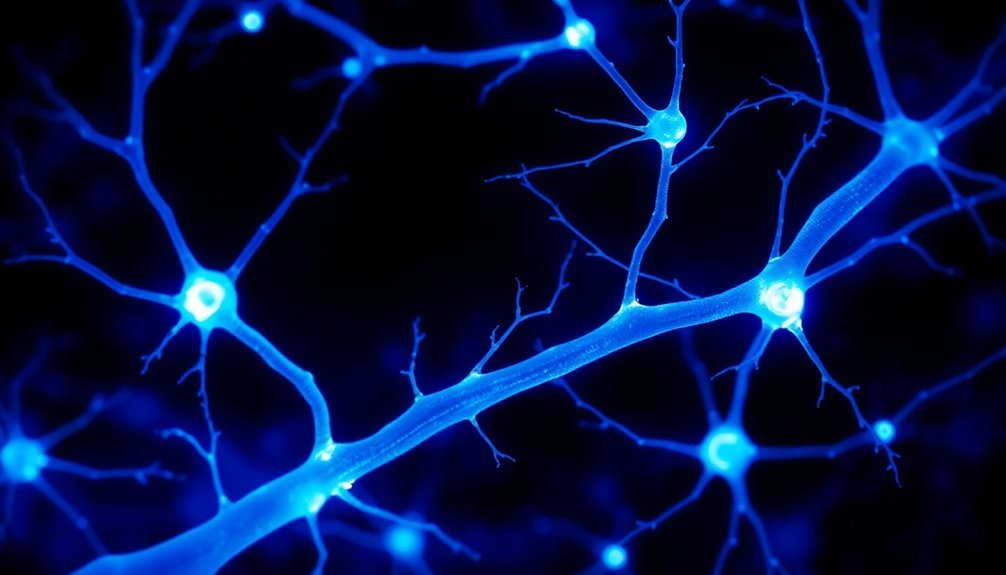
As LED therapy continues to evolve, several promising developments are shaping the future of nerve regeneration treatment. You'll see significant advancements in optimized wavelengths and delivery methods, with researchers focusing on specific frequencies like 660 nm and 780 nm that have shown remarkable effectiveness in promoting nerve regeneration.
Clinical applications are expanding rapidly, particularly in treating spinal cord injuries. You can expect to see new implantable devices that'll deliver precise light therapy directly to injured areas. These developments are backed by successful preclinical trials that demonstrate improved nerve regeneration and functional recovery.
Commercial partnerships are forming to develop prototype devices for clinical trials, bringing LED therapy closer to widespread medical use.
Standardization efforts are underway to establish consistent dosing regimens, making treatments more reliable and reproducible.
Advanced delivery systems are being created to improve the efficiency and accuracy of light therapy applications.
The path forward includes obtaining necessary regulatory approvals and conducting larger-scale clinical trials. You'll likely see these developments transform into practical treatments as researchers validate LED therapy's effectiveness across various nerve injury conditions, potentially revolutionizing how we approach nerve regeneration treatment.
Frequently Asked Questions
Can LED Therapy Cause Skin Damage or Burns During Treatment?
Yes, you can get skin damage or burns from LED therapy, especially with home treatments. You'll reduce risks by following prescribed dosages, using quality devices, and getting treatments under medical supervision.
Are There Any Age Restrictions for Receiving LED Nerve Regeneration Therapy?
You can receive LED nerve regeneration therapy at any age, but you'll likely see better results if you're younger. While it's safe for all ages, younger patients typically experience faster nerve regeneration.
Does Insurance Typically Cover LED Treatment for Peripheral Nerve Regeneration?
You'll typically need to pay out-of-pocket for LED nerve regeneration treatments, as most insurance companies and Medicare don't cover them. They're usually considered experimental, and aren't included in standard medical coverage plans.
Can LED Therapy Be Used While Taking Medications for Nerve Pain?
You can generally use LED therapy while taking nerve pain medications as studies show no significant interference. However, you should always consult your healthcare provider first to monitor your individual response and treatment plan.
How Soon After Nerve Injury Should LED Treatment Ideally Begin?
You should ideally begin treatment immediately after nerve injury for the best recovery outcomes. Don't wait too long – research shows early intervention is essential, though you'll need your doctor's guidance on specific timing.
In Summary
You'll find LED therapy offers promising advances in peripheral nerve regeneration through targeted photobiomodulation. With specific wavelengths promoting faster healing and reduced inflammation, you can expect improved recovery outcomes when combining LED treatments with conventional therapies. While research continues to evolve, you're looking at a non-invasive solution that's proving effective for nerve repair. The future of LED treatment holds exciting potential for revolutionizing neurological recovery protocols.
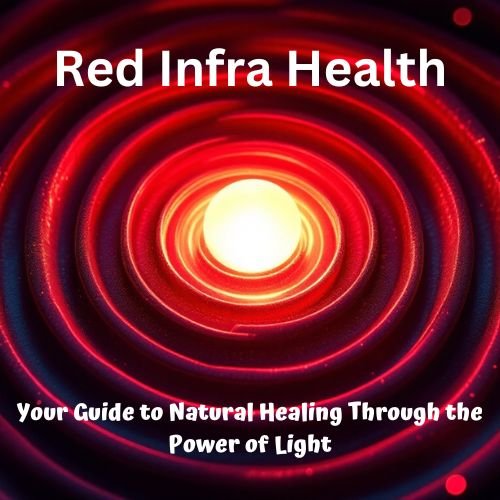


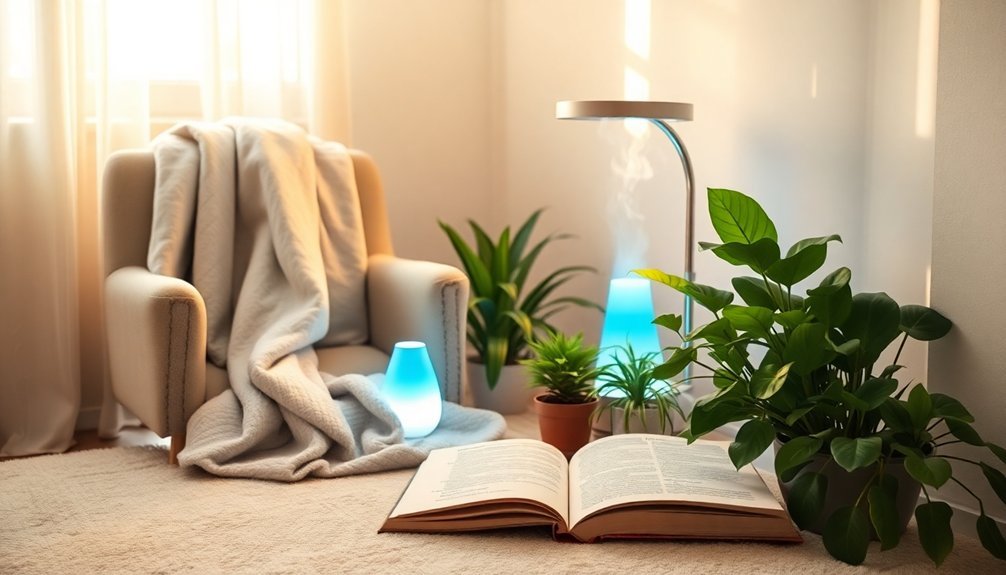

Leave a Reply